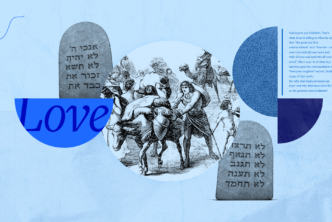In Revelation 1:4–5, John gives what appears to be a Trinitarian greeting from God, the Spirit, and Jesus; but in place of the Spirit he highlights the “seven spirits before his throne.”
John: To the seven churches in Asia. Grace and peace to you from the one who is, who was, and who is to come, and from the seven spirits, before his throne, and from Jesus Christ.1
These seven spirits appear three more times in Revelation:
Thus says the one who has the seven spirits of God and the seven stars. (3:1)
Seven fiery torches were burning before the throne, which are the seven spirits of God. (4:5)
He had seven horns and seven eyes, which are the seven spirits of God sent into all the earth. (5:6)
These references raise an important question: Why does John replace an expected reference to the Holy Spirit with a reference to seven spirits of God? What does this mean?
Symbolic apocalyptic visions defy all attempts at perfect systematization. The seven spirits of God are symbolically described two different ways in two consecutive chapters (as seven torches in 4:5 and seven eyes in 5:6). This is not a problem, however; communication of symbolic meaning is more important than logical consistency throughout Revelation.
Revelation is full of visionary and symbolic descriptions of reality, and it is often essential to identify both relevant allusions to the Old Testament and points of contact with ideas which would have been known to John’s original hearers. Our interpretations must focus, as much as we can determine, on what John would have meant to communicate and what his original hearers would have understood; we must not interpret Revelation from our own historical and cultural perspective without regard for this original historical and literary context. If a particular interpretation of Revelation would not have made any sense to the original hearers, it is likely incorrect.
Old Testament allusions
Interpreters generally point to one main Old Testament allusion with a secondary possible relevant allusion. First, John’s seven spirits could be an allusion to the seven lamps in Zechariah 4:2–10, where the seven lamps in the vision are associated both with God’s Spirit and the seven eyes of the Lord. There is also a possible allusion to the seven attributes of the Spirit in Isaiah 11:2 (i.e., a Spirit of the Lord, of wisdom, of understanding, of counsel, of strength, of knowledge, and of the fear of the Lord). In both these cases, the Spirit is associated with the number seven or a sevenfold description, and in Zechariah, in particular, the plural number seven points to the singular Spirit.
View 1: The Holy Spirit
In Zechariah and Revelation, the number seven represents completion and wholeness; so the seven or sevenfold spirit in Revelation could be a symbolic description of the Holy Spirit. This is the most common interpretation today, and indeed it makes sense of how the seven spirits fill the slot of the Holy Spirit in what would seem to be a Trinitarian greeting in Revelation 1:4. It also explains why the seven spirits are so closely connected to God’s throne (4:5) and are likewise intimately connected to Jesus (3:1; 5:6). There is a close and intimate relationship between the Father, the Son, and the Spirit in Revelation: everything that Jesus says to the churches in Revelation 2–3 is also described as what the Spirit is saying to the churches (Rev 2:7, 11, 17, 29; 3:6, 13, 22); the Spirit is involved with the reception of John’s vision (Rev 1:10; 4:2; 17:3; 21:10); the Spirit speaks (Rev 14:13; 22:17); and the Spirit is associated with faithful prophecy (19:10). God, the Spirit, and Jesus can be understood as one (monotheism) without losing their individual identity. John, of course, doesn’t use the word “Trinity,” but he provides the conceptual material needed to develop that later theological conclusion.
View 2: The 7 Angels in Second Temple Judaism
Weighing the relevant historical, literary, and theological evidence differently, some interpreters argue that the seven spirits point to the seven well-known angels in Second Temple Judaism (Tob 12:15; 1 Enoch 20:1–8). According to 1 Enoch, these angels are Uriel, Raphael, Raguel, Michael, Saraqâêl, Gabriel, and Remiel.
And these are the names of the holy angels who watch. Uriel, one of the holy angels, who is over the world and over Tartarus. Raphael, one of the holy angels, who is over the spirits of men. Raguel, one of the holy angels who takes vengeance on the world of the luminaries. Michael, one of the holy angels, to wit, he that is set over the best part of mankind and over chaos. Saraqâêl, one of the holy angels, who is set over the spirits, who sin in the spirit. Gabriel, one of the holy angels, who is over Paradise and the serpents and the Cherubim. Remiel, one of the holy angels, whom God set over those who rise. (1 Enoch 20:1–8).
I am Raphael, one of the seven angels, which stand and enter before the glory of the Lord. (Tob 12:15).
These angels would have been well-known to many first century Jews and are closely associated with God in the texts which discuss them. Gabriel (Dan 8:16; 9:21; Luke 1:19, 26) and Michael (Dan 10:13, 21; 12:1; Jude 9; Rev 12:7) feature prominently in Daniel and in the New Testament and were well-known to the first Christians. In Revelation and other Second Temple Jewish sources, angels could be described as spirits, and John does assume an angelic hierarchy with different angels featuring prominently throughout the book. Even though the New Testament authors were much more interested in the angelic world than many modern readers, they demonstrate considerable restraint and do not engage in the kind of speculation and discussion evident in many contemporary Second Temple sources. If the seven spirits are viewed as seven powerful angels, the Holy Spirit, as noted above, is still present and active in Revelation in essential ways.
Conclusion
The allusion to Zechariah 4:2–10 seems to favor a symbolic interpretation of the seven spirits as a way of describing the fullness of the single Holy Spirit, but the alternative choice is not heretical. One’s interpretation of the seven spirits in Revelation does not require a choice between a conservative or orthodox interpretation on one hand and a liberal or heretical interpretation on the other. It rather involves the weighing of historical, literary, and theological evidence to try to determine, as best we can, what John thought the expression meant and what his first hearers would have understood by it.
To summarize, many interpreters take John’s references to the seven spirits of God as a symbolic way to point to the single Holy Spirit and to draw the hearer’s attention back to Zechariah 4:2–10. Alternatively, those who take the expression as seven archangels do not thereby remove the Holy Spirit from the book.
Related resources
Jesus and the God of Israel: God Crucified and Other Essays on the New Testament’s Christology of Divine Identity
Regular price: $28.99







